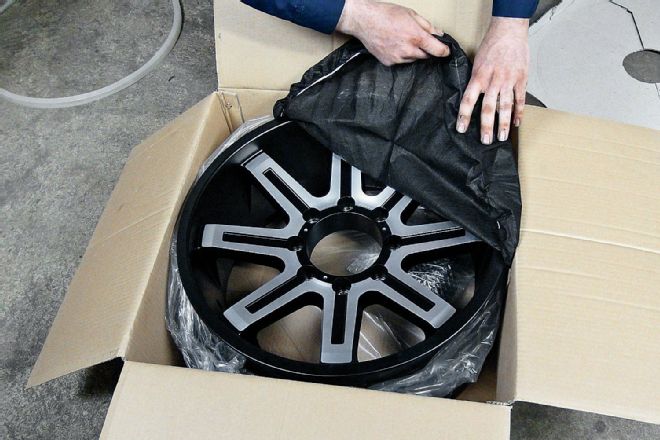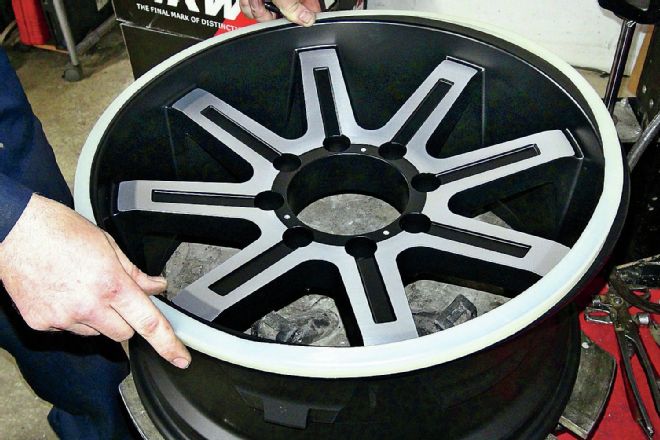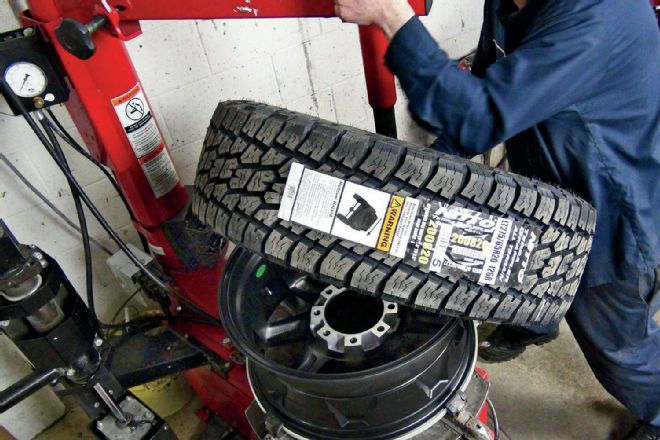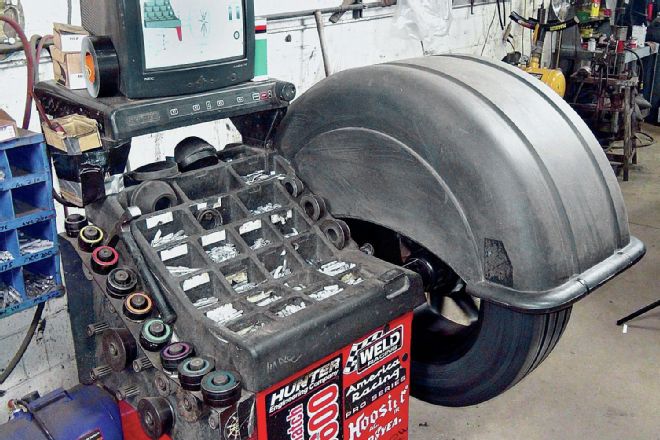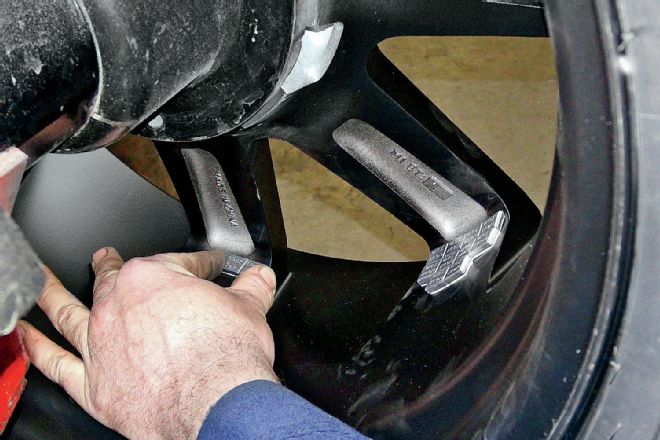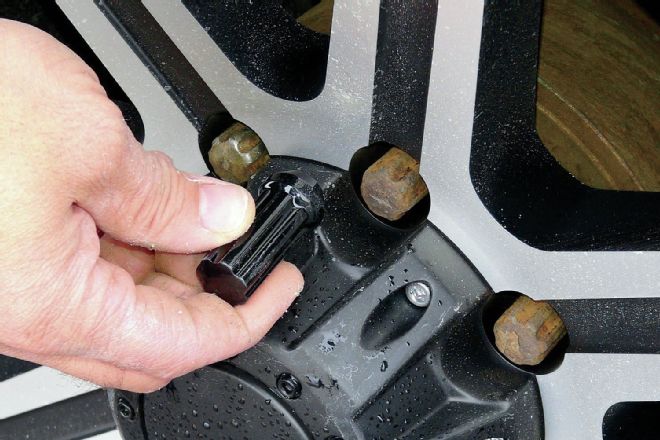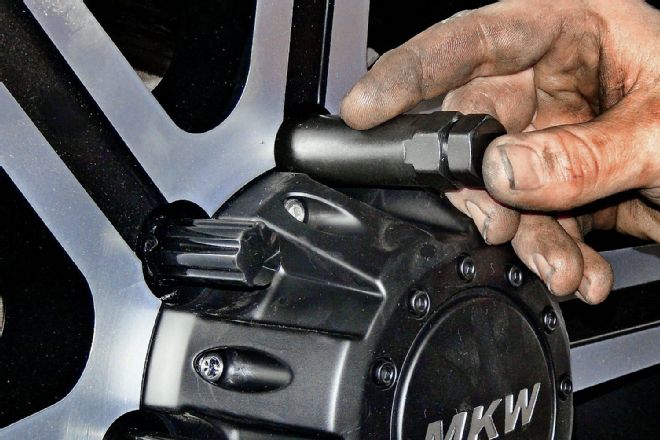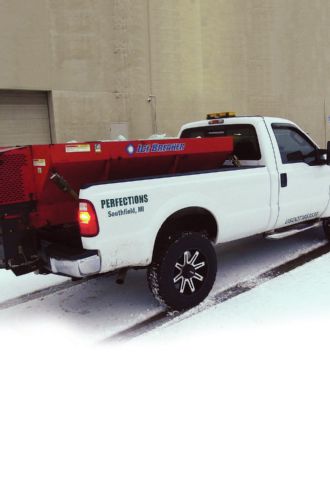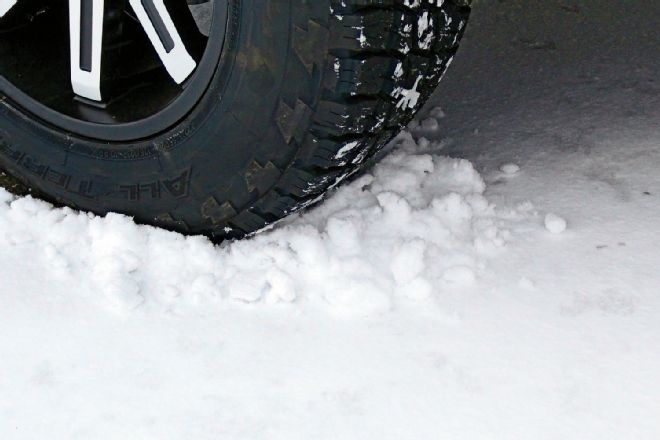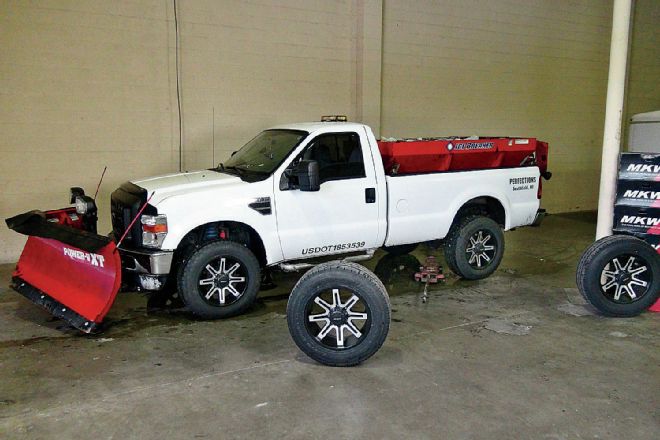We know there are a lot of Work Truck Review magazine enthusiasts out there making a living with their trucks in the winter months—and looking to get the best snow traction from their vehicles in cold, snowy conditions while looking as good as ever. Well, never fear, Work Truck fans, as we are on the job of detailing how to get maximum traction performance from your snow-trucker with impressive 20-inch rims and tires. In this case, we performed stopping-distance testing on a fully loaded snow-pusher with a variety of 20-inch tires to quantify the difference tire selection has on snowy stopping distance. The results were surprising.
The Tires
Three different tire designs were tested for this story. And just to clarify, this isn't a tire "comparison" story. Our goal here was to showcase how different tire designs perform in wintry conditions to help you with your purchase decisions. These tires are all excellent performers, and each has their own personality and performance capabilities.
Which tire you choose to run on your truck really depends on what your needs are. The three tire designs we ran in the snow included:
Nitto Dura Grappler, LT275/65R20
The Dura is a highway radial tire that thinks it is an all-terrain tire. It features bridged tread blocks designed to reduce irregular tire wear and heat buildup and a harder rubber compound to provide up to 60,000-mile treadwear life (with a warranty on select tires). A three-steel belt technology is employed to increase tire life and load capability. For improved grip in wet and snowy conditions, circumferential grooves run between the tread blocks to evacuate water from the tread pattern. Also, the Dura Grappler features waved sipes (slits in the tread blocks) to further improve wet weather performance while maintaining tread block rigidity. For appearance choices, the Dura offers two distinct sidewall designs (one on each side).
Nitto Terra Grappler, LT275/65R20
The best way to describe the Terra Grappler radial truck tire is with the word “balance.” It is an all-season, all-terrain tire that balances wet and dry performance with on-road comfort to produce a quiet, good-looking tire that works either on the road or in the dirt.
It features deep sipes (which are slits in the tread block to promote grip) and lateral voids arranged to channel the maximum amount of water, tread coupling blocks to provide excellent dry traction performance, an optimized tread block-to-void ratio to balance on-road and off-road performance, and staggered tread block shoulders to maximize traction in sand or loose gravel.
Toyo Open Country WLT1, LT275/65R20
The WLT1 is in a class all its own. It is a commercial truck, "winter" radial tire designed to provide excellent performance on snow/slush/ice and handle heavy loads at the same time. The WLT1 is a 10-ply truck tire that features extra deep sipes to provide better grip in wintry conditions; interlocking tread blocks; an extra deep, open-block tread design; dimpled side blocks, and offset tread blocks to minimize road noise and maximize traction. The one thing to remember is that the WLT1 is a winter-only tire, so using it in temperatures above 45 degrees will lead to premature wear. But in cold, sloppy conditions, these tires are the deal.
MKW Wheels
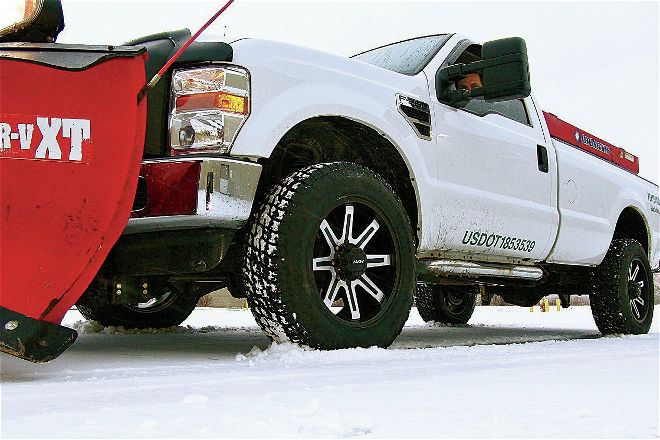
| The same wheels were used for all the testing: MKW M88 cast-aluminum rims. The three types of tires (two sets of Nittos and one set of Toyos) were mounted and balanced prior to the test day by Harlow Tire in Westland, Michigan, so we could focus on running the tests and swapping the rim/tire combos. This is a real work truck that sees constant use all winter, so it was an excellent testbed for this story. The test area had not been salted all season and featured a fresh coat of snow from the night before—perfect for this testing.
We wanted to run the same rim for all of these tires to eliminate any variations caused by different rims. For us, there was only one choice: MKW Wheels…for multiple reasons. First, MKW offers one-piece, 20-inch-and-larger-diameter rims in beautiful designs with OE levels of quality. Even better, MKW offers these wheels with OE-style backspacing options. This is important, because we wanted to show how a truck can be upfitted with 20-inch wheels and tires for their impressive look but keep the performance the vehicle had from the factory.
You've probably heard that using a "centered" rim (which means a 9-inch-wide rim with a backspacing of 4.50 inches) helps the stability of a vehicle by widening the track width. The negative aspect of this is that using a centered rim that has less backspacing than the factory rim increases the “scrub radius.” This is the distance from the centerline of the suspension steering rotation point (represented by an imaginary line drawn through the two ball joint pivot points for the front spindles) and the center of the tire contact patch. Under panic braking, this can change the performance of an ABS system.
Another negative of centered backspacing wheels is that using less backspacing positions the wheels and tires further out from the edge of the fenders—which means if you don't add fender flares, you will probably be regularly splattering mud and goo up onto the body. For some folks, this is a badge of honor. If you are trying to keep your work truck clean and look factory at the same time, wheels tucked into the wheelwells with as close to the factory backspacing as possible are for you.
Simply put, the MKW wheels are beautiful, install and work like a production-vehicle rim, and look great years down the road.
Mounting, Balancing, and Installing Wheels and Tires
We went to Harlow Tire, in Westland, Michigan, to get the Nitto and Toyo tires installed on the MKW wheels. Harlow has decades of experience mounting and balancing tires and wheels, so the crew knew exactly what to do to get the tire and wheel combo looking great and ready for the road.
Hiding Wheel Weights
Harlow Tire has wheel/tire balancing machines that recognize where the spokes of the wheels are located. So, the balancer machine tells the operator to put the weights behind the spokes! Voila! The wheel/tire combo looks super clean but is balanced. This is another one of those small things that adds up to make a difference (and help the MKWs and Nittos/Toyos look that much better on the vehicle).
Lug Nuts
We did a story with MKW Wheels about three years ago using chrome lug nuts. While the MKW wheels still look brand-new (which is very impressive—you can see why we wanted to work with them again!), the chrome lug nuts look like they came from the bottom of the ocean. In hopes of avoiding appearance degradation, Harlow recommended using black anodized lug nuts for this package.
These lug nuts install with a custom, deep-well socket adapter that has both a metric and standard hex on the end of it—so you use this to tighten the lug nuts on the lugs.
As a tip, Harlow recommended not using an impact wrench with these lug nuts to minimize the degradation to the coating on them—so all the lug nuts were hand-torqued on the wheels!
Testing Procedure
The process used to generate the data for this story mimics the testing performed on new vehicles in wintry conditions. For each set of tires, five panic stops—like the “mash the brake pedal to the floor and hold it” kind in which the ABS activates—were recorded using a DL1 data logger system (which has GPS location capability). The stops were all performed on a snow-covered, non-salted parking lot with the vehicle going a little more than 31 mph.
The five stops were averaged to create the published numbers (below), and a correlating stop was done before and after the testing stops to ensure the surface was comparable from the beginning to the end of the stops (it was).
The vehicle was loaded with a snowplow assembly and a full salt box—which put this '01 Ford F-250 just under its gross vehicle weight (GVW) rating. Tire pressures were set at the appropriate pressure (psi) for the load rating.
Summary: The Dura tires from Nitto performed well for a year-round, highway tire. The all-terrain Nitto Terra tires did surprisingly well in the snow by stopping almost 7 feet shorter than their highway-based brothers. The winter-only Toyo WLT1 tires really showed the true capability of a truck-rated, winter-only tire—stopping 12 feet shorter than the highway-based, year-round tire, and 5½ feet shorter than the all-terrain tire.
So, what did we learn? Well, the all-terrain Nitto Terra tires have some pretty darn good traction in the snow, and you can run them year-round. The Dura tires are good all around, but if you are doing a lot of work in the snow, you might consider having a set of winter-only tires mounted up so you can bolt them on when the white stuff flies.
With that in mind, if you are looking for the ultimate in winter traction, the Toyo WLT1 winter tires are the way to go. Yes, you will need another set of rims and tires to run in the winter months, but if you need the best possible traction for snow, ice, slush, and frozen gunk while handling heavy loads—a tire designed for winter-only use is your best bet.
Snow Stopping Distance Results Avg. Stopping Dist. from 31 mph:
•Nitto Dura Grappler 104.3 feet
•Nitto Terra Grappler 97.5 feet (6.8 feet shorter than Dura)
•Toyo Open Country WLT1 91.9 feet (12.4 feet shorter than Dura, and 5.6 feet shorter than Terra)
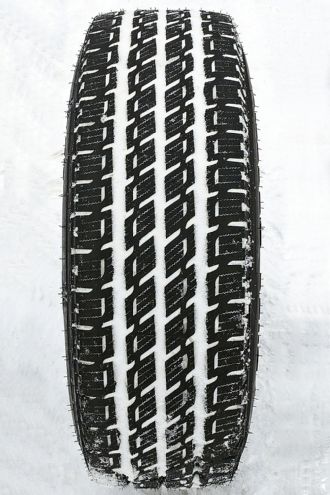
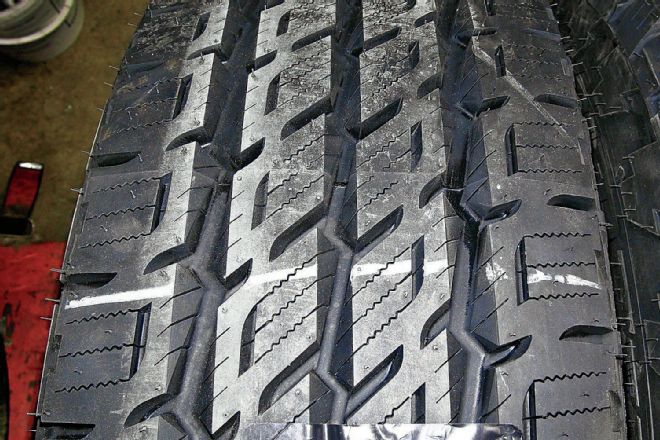
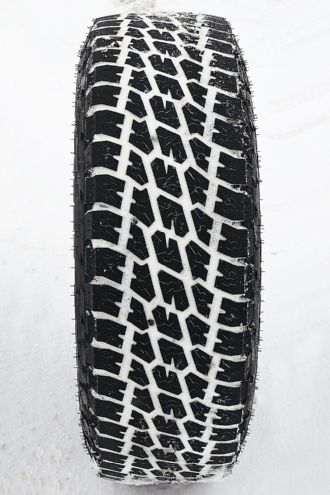
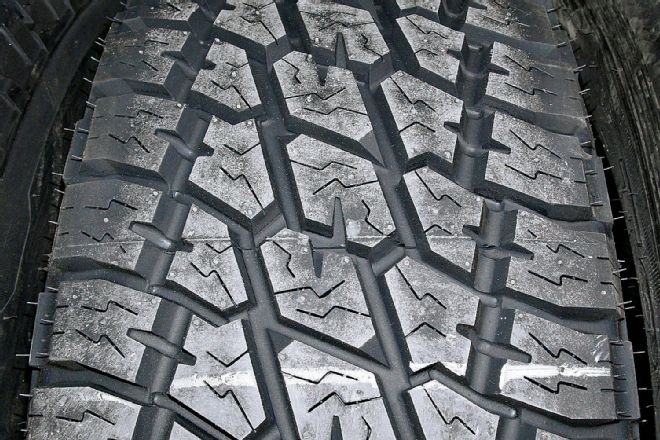
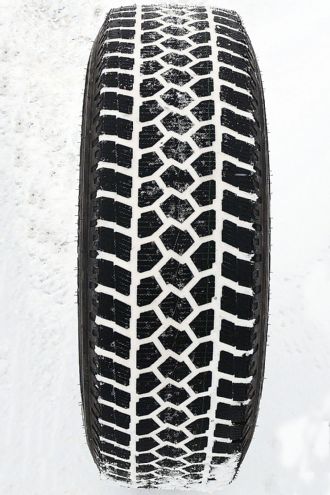
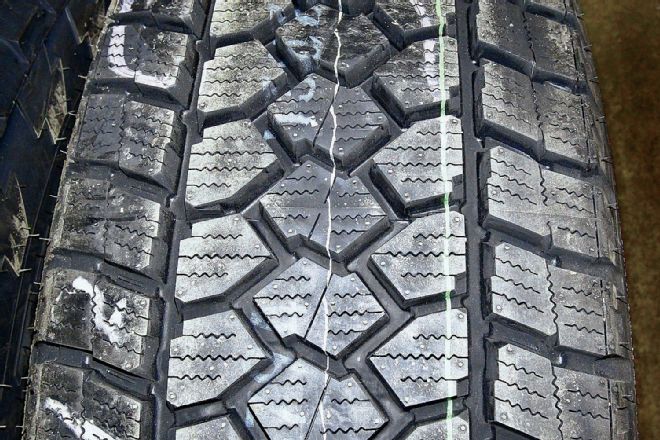
 | The same wheels were used for all the testing: MKW M88 cast-aluminum rims. The three types of tires (two sets of Nittos and one set of Toyos) were mounted and balanced prior to the test day by Harlow Tire in Westland, Michigan, so we could focus on running the tests and swapping the rim/tire combos. This is a real work truck that sees constant use all winter, so it was an excellent testbed for this story. The test area had not been salted all season and featured a fresh coat of snow from the night before—perfect for this testing.
We wanted to run the same rim for all of these tires to eliminate any variations caused by different rims. For us, there was only one choice: MKW Wheels…for multiple reasons. First, MKW offers one-piece, 20-inch-and-larger-diameter rims in beautiful designs with OE levels of quality. Even better, MKW offers these wheels with OE-style backspacing options. This is important, because we wanted to show how a truck can be upfitted with 20-inch wheels and tires for their impressive look but keep the performance the vehicle had from the factory.
You've probably heard that using a "centered" rim (which means a 9-inch-wide rim with a backspacing of 4.50 inches) helps the stability of a vehicle by widening the track width. The negative aspect of this is that using a centered rim that has less backspacing than the factory rim increases the “scrub radius.” This is the distance from the centerline of the suspension steering rotation point (represented by an imaginary line drawn through the two ball joint pivot points for the front spindles) and the center of the tire contact patch. Under panic braking, this can change the performance of an ABS system.
Another negative of centered backspacing wheels is that using less backspacing positions the wheels and tires further out from the edge of the fenders—which means if you don't add fender flares, you will probably be regularly splattering mud and goo up onto the body. For some folks, this is a badge of honor. If you are trying to keep your work truck clean and look factory at the same time, wheels tucked into the wheelwells with as close to the factory backspacing as possible are for you.
Simply put, the MKW wheels are beautiful, install and work like a production-vehicle rim, and look great years down the road.
Mounting, Balancing, and Installing Wheels and Tires
We went to Harlow Tire, in Westland, Michigan, to get the Nitto and Toyo tires installed on the MKW wheels. Harlow has decades of experience mounting and balancing tires and wheels, so the crew knew exactly what to do to get the tire and wheel combo looking great and ready for the road.
| The same wheels were used for all the testing: MKW M88 cast-aluminum rims. The three types of tires (two sets of Nittos and one set of Toyos) were mounted and balanced prior to the test day by Harlow Tire in Westland, Michigan, so we could focus on running the tests and swapping the rim/tire combos. This is a real work truck that sees constant use all winter, so it was an excellent testbed for this story. The test area had not been salted all season and featured a fresh coat of snow from the night before—perfect for this testing.
We wanted to run the same rim for all of these tires to eliminate any variations caused by different rims. For us, there was only one choice: MKW Wheels…for multiple reasons. First, MKW offers one-piece, 20-inch-and-larger-diameter rims in beautiful designs with OE levels of quality. Even better, MKW offers these wheels with OE-style backspacing options. This is important, because we wanted to show how a truck can be upfitted with 20-inch wheels and tires for their impressive look but keep the performance the vehicle had from the factory.
You've probably heard that using a "centered" rim (which means a 9-inch-wide rim with a backspacing of 4.50 inches) helps the stability of a vehicle by widening the track width. The negative aspect of this is that using a centered rim that has less backspacing than the factory rim increases the “scrub radius.” This is the distance from the centerline of the suspension steering rotation point (represented by an imaginary line drawn through the two ball joint pivot points for the front spindles) and the center of the tire contact patch. Under panic braking, this can change the performance of an ABS system.
Another negative of centered backspacing wheels is that using less backspacing positions the wheels and tires further out from the edge of the fenders—which means if you don't add fender flares, you will probably be regularly splattering mud and goo up onto the body. For some folks, this is a badge of honor. If you are trying to keep your work truck clean and look factory at the same time, wheels tucked into the wheelwells with as close to the factory backspacing as possible are for you.
Simply put, the MKW wheels are beautiful, install and work like a production-vehicle rim, and look great years down the road.
Mounting, Balancing, and Installing Wheels and Tires
We went to Harlow Tire, in Westland, Michigan, to get the Nitto and Toyo tires installed on the MKW wheels. Harlow has decades of experience mounting and balancing tires and wheels, so the crew knew exactly what to do to get the tire and wheel combo looking great and ready for the road.
